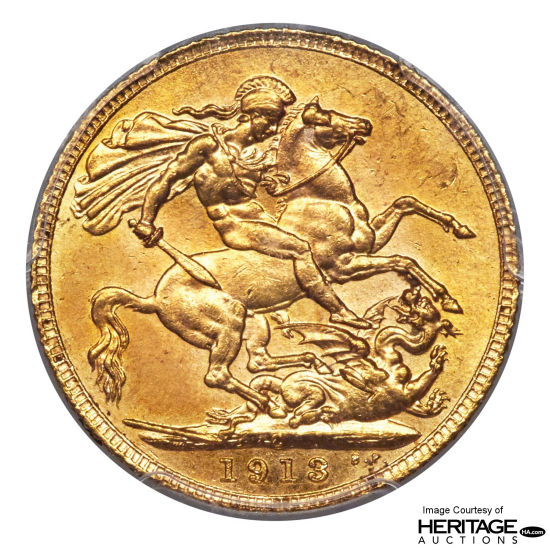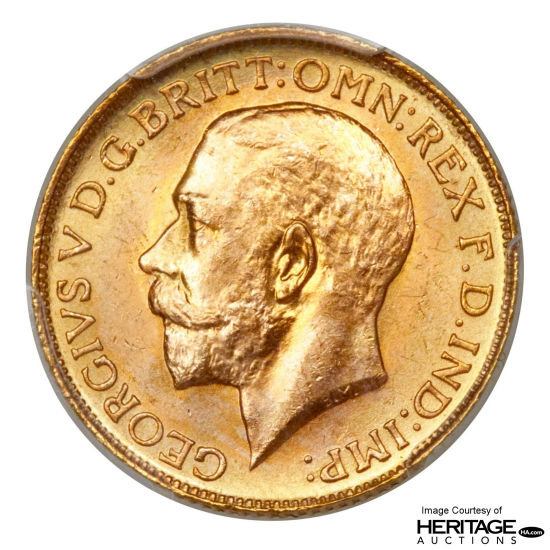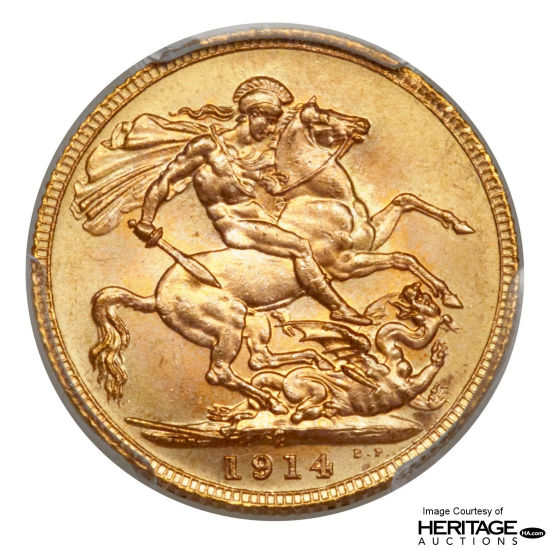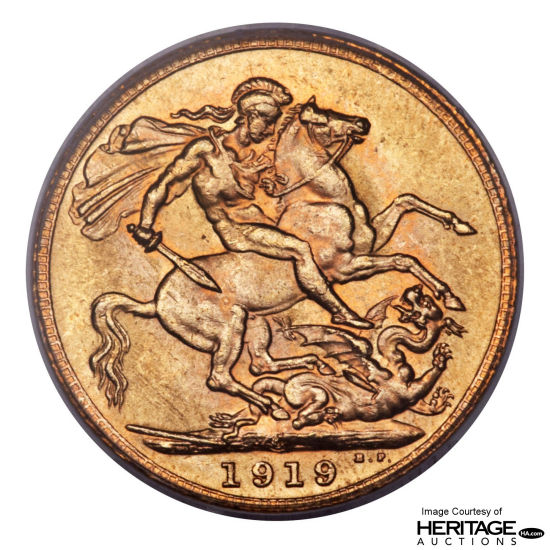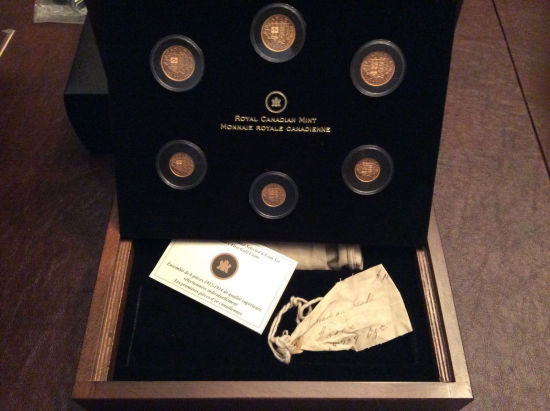Canadian Vintage Gold Coins
Table of Contents:
Preface
1908c Gold SovereignMintage: 636 Finish: Specimen only 1908 thru 1910 Obverse design by George W. DeSaulles: The effigy of King Edward VII with the surrounding text "EDVARDIS VII D: G: BRITT: OMN: REX: F: D: IND: IMP:", which translates to "Edward VII: By The Grace Of God, Of All The Britains, King, Defender Of The Faith, And Emperor Of India" The engravers initials can be found below the truncation of the King's neck. 1908 thru 1910 Reverse design by Bennedetto Pistrucci: The image of St. George on horseback, slaying a dragon. The letter "C" (representing the fact that this coin was minted in Canada) can be found on the ground below the horse. Below this is the year of production and the engraver's initials The 1908 coin was struck only in specimen quality for inclusion in the specimen sets of 1908. Grades lower than -60 are considered "impaired specimens", and should never be assigned an MS (Mint State) grade. |
|
1911c Gold SovereignMintage: 256,946 Finish: Circulation With the death of King Edward VII and the coronation of King George V, the obverse of the coin was changed to contain the new King's effigy. The Reverse design remained consistent with the 1908-1910 coins. 1911 thru 1919 Obverse design by Sir E.B. MacKennal: The effigy of King George V with the surrounding text "GEORGIVS V D.G.BRITT: OMN: REX: F.D. IND: IMP:", which translates to "George V: By The Grace Of God, Of All The Britains, King, Defender Of The Faith, And Emperor Of India" The engravers initials can be found on the truncation of the King's neck. 1911 thru 1919 Reverse design by Bennedetto Pistrucci: The image of St. George on horseback, slaying a dragon. The letter "C" (representing the fact that this coin was minted in Canada) can be found on the ground below the horse. Below this is the year of production and the engraver's initials Note: No gold sovereigns were produced in 1912. |
|
1916c Gold SovereignMintage: 6,111 Finish: Circulation Despite the fact that the 1908 and 1913 mintages were considerably lower than this year, the collector value of this year is dramatically higher for the following reason: It is believed that only about 50 examples are known to exist. One theory is that most of this issue was melted down, while another (widely disagreed with) theory is that the majority of the Canadian 1916 sovereigns were lost at sea during transport to England. In either case, this is considered to be the "Holy Grail" of Canadian gold sovereign coins. |
|
Part 2 - Canada's First "True" Gold Coins
|
In 1912, the Dominion Government ordered 8,000 five-dollar gold coins, and 8,000 10-dollar gold coins minted. The weights and fineness (90% gold) of the coins were identical to the American coins being produced at the same time, so they could be used back and forth for equal value. With the completion of Canada's first gold refinery in 1911, all of the Canadian gold coins were struck with gold mined in Canada. By the end of that summer, $600,000 worth of gold coins had been circulated to Assistant-Receivers General across Canada. Production of the gold coins continued until 1914, when it was decided to hoard the vast majority of gold to finance the war effort. At the same time, the call went out requesting people who held gold coins to exchange them for paper currency, so the government could control the nation's supply of gold. From that point on, until the modern era, all Canadian gold bullion was produced in the form of bars. |
1912 Canada Gold 5 DollarMintage: 165,680 The reverse consists of the Arms of Dominion of Canada (composed of the provincial arms of the four member provinces of the Dominion of Canada: Ontario, Quebec, Nova Scotia, and New Brunswick), surrounded by wreaths of maple leaves. Above the shield is the inscription CANADA, and below it is the year and denomination. The obverse features the portrait of British monarch King George V, who ruled from 1910 to his death in 1936. |
|
Part 4 - End Of An Era: The Release of the Mint Hoard
|
Historically, most nations used gold and silver as their only forms of currency. Because of their bulk, these countries eventually switched to paper currency. A paper bill was simply a promissory note worth the same amount in gold or silver. Because of this every nation had to hold enough gold and silver in their vaults to cover the exchange of every paper bill that was in circulation. Over time, most nations have moved off the "Gold Standard" method of documenting it's wealth, and have changed to investments. Because of this there was no longer any need to hoard vast amounts of gold. Slowly but surely they have all sold off their gold hoards. In 2012, the Bank of Canada began this process by announcing the sale of 30,000 hand-selected specimens from the hoard of approximately 245,000 gold coins stored in cloth bags and locked in its vault since the 1930s. The remaining 215,000 coins were melted into bars. The 30,000 coins deemed of the highest quality by Mint personnel were divided into two categories: Hand-Selected and Premium Hand-Selected, the difference being that a consumer could either pay a premium to be guaranteed a piece of the highest quality or pay regular price for an item chosen at random from the available supply. The Bank of Canada Hoard of $5 and $10 gold coins went on sale starting November 28, 2012 and shipped a month later on December 28. Regardless of the type, all coins offered for sale to collectors were shipped inside a clear coin capsule, sealed shut by a holographic label for security. The coins were sold exclusively through the Royal Canadian Mint. According to the Mint, purchasing options included: |
Premium Hand-Selected 6-Coin Set (140 sets - $12,000 each), 840 coins total. Each Premium set came with an official Certificate of Authenticity, as well as one of the original bags and tags that held and identified the coins in the Bank of Canada's vault. The set was packaged inside a wooden display box |
|
Premium Hand-Selected 1912, 1913 and 1914 $5 single gold coins (291 coins - $875 each). All single coins were packaged inside a wooden clamshell style case and came with a Certificate of Authenticity. |
|
Premium Hand-Selected 1913 and 1914 $10 single gold coins (4,869 coins - $1,750 each) All single coins were packaged inside a wooden clamshell style case and came with a Certificate of Authenticity. |
|
Hand-Selected 1912, 1913 and 1914 $5 single gold coins (5,050 coins - $500 each). All single coins were packaged inside a vinyl covered clamshell style case and came with a Certificate of Authenticity. |
|
Hand-Selected 1912, 1913 and 1914 $10 single gold coins (18,950 coins - $1,000 each). All single coins were packaged inside a vinyl covered clamshell style case and came with a Certificate of Authenticity. |
|
Premium Hand-Selected product options accounted for 6,000 of the 30,000 gold coins, while Hand-Selected options accounted for the remaining 24,000. The purchase of each Premium Hand-Selected collectible was restricted to one per household and Hand-Selected items were held to a household limit of three per option. It is currently unknown if original survivors of the gold coin sales which occurred between 1912 and 1914 will hold any premium value when compared to coins sold from the hoard in 2012. It might also be difficult to certify the provenance of any ungraded survivor from the original 1912-1914 sales. Any survivors which were graded prior to the release of the hoard can be proven by looking up the date it was graded. |
Part 5 - Coin Specifications
|
Date Range and Denomination
|
Mintage
|
Obverse Designer
|
Reverse Designer
|
Composition
|
Weight
|
Diameter
|
Edge Style
|
|
1908-1910 1 Pound Gold Sovereign
|
44,921
|
George W. DeSaulles
|
Benedetto Pestrucci
|
0.917 Gold
0.083 Copper |
7.99g
|
22.05mm
|
Reeded
|
|
1911-1919 1 Pound Gold Sovereign
|
582,913
|
Sir E. B. Mackennal
|
Benedetto Pestrucci
|
0.917 Gold
0.083 Copper |
7.99g
|
22.05mm
|
Reeded
|
|
1912-1914 $5
|
295,634
|
Sir E. B. Mackennal
|
W. H. J. Blakemore
|
0.900 Gold
0.100 Copper |
8.36g
|
21.59mm
|
Reeded
|
|
1912-1914 $10
|
364,059
|
Sir E. B. Mackennal
|
W. H. J. Blakemore
|
0.900 Gold
0.100 Copper |
16.72g
|
26.92mm
|
Reeded
|
|
1928 $5 Pattern
|
?
|
Sir E. B. Mackennal
|
George E. Kruger-Gray
|
0.100 Copper
|
4.18g
|
21.7mm
|
Reeded
|
|
1928 $10 Pattern
|
?
|
Sir E. B. Mackennal
|
George E. Kruger-Gray
|
0.100 Copper
|
8.55g
|
27mm
|
Reeded
|










